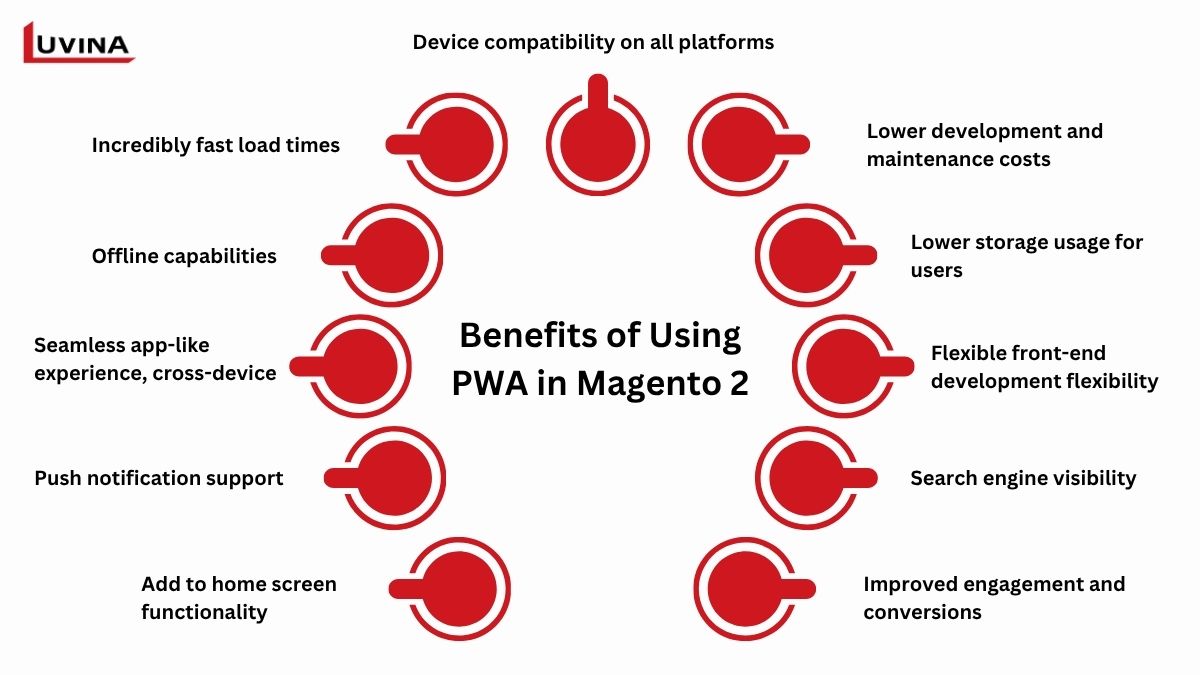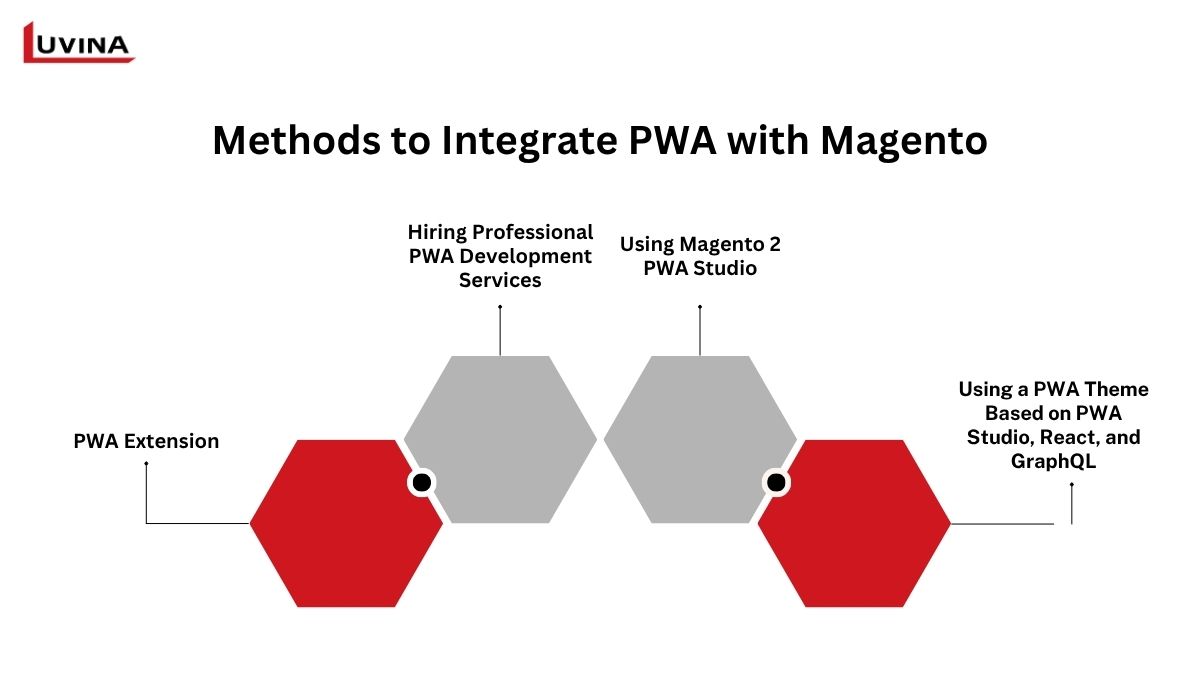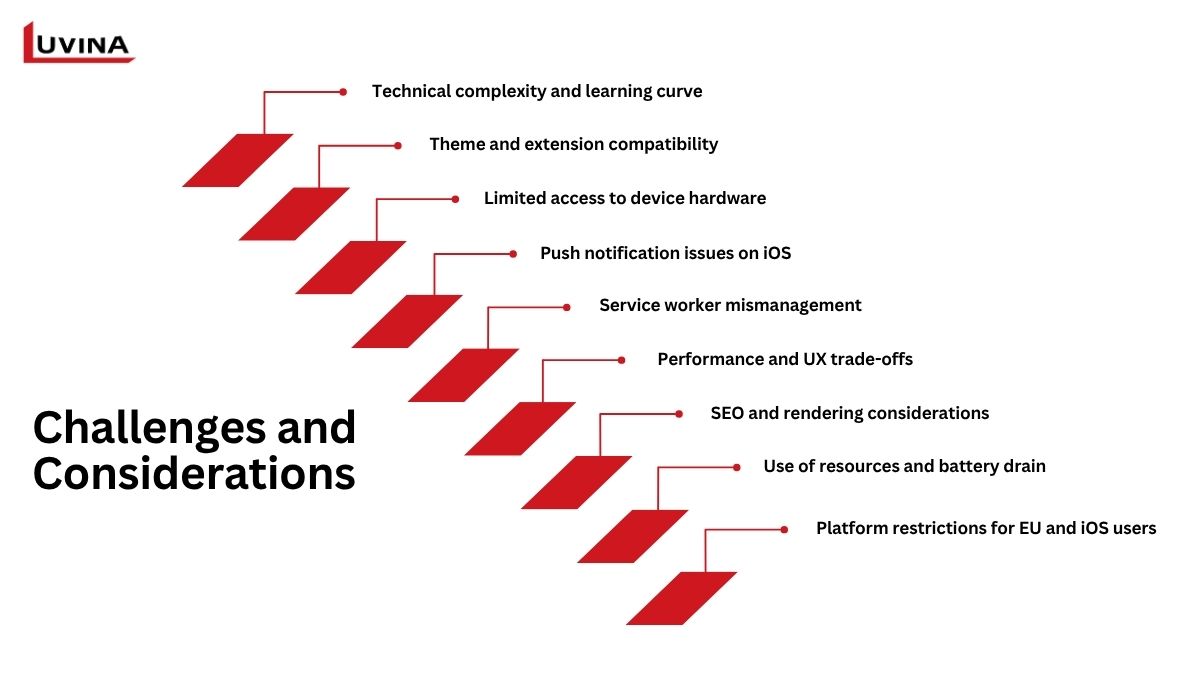Mobile devices accounted for more than 60% of all worldwide ecommerce sales in 2023, yet many Magento stores still lag in speed and user experience on mobile. That’s not just a trend; it’s a wake-up call. Native app development is expensive. But ignoring mobile experience costs even more in lost conversions, slower SEO, and abandoned carts. For any brand wanting to remain relevant in a mobile-first world, offering a smooth, app-like experience on the web with a Magento progressive web app is now required, not discretionary.
Still, what exactly is a Magento PWA? Under the hood, how does it function? Why is it becoming the go-to option for contemporary business? This guide covers key questions to help businesses evaluate if it’s the ideal match for your online business.
What is a Progressive Web App (PWA)?
A Progressive Web App (PWA) combines the performance and interactivity of a native mobile app with the simplicity of a website. A Magento Progressive Web App (PWA), built with HTML, CSS, and JavaScript, delivers fast loading, offline access, and push notifications. Users enjoy smooth interactions across devices without installing anything from an app store.
In an eCommerce environment, a Magento progressive web app turns a Magento store into a lightning-fast, mobile user-specific experience. Unlike conventional mobile sites, PWAs have their accessibility through a browser while operating natively. This gives companies that give mobile-first plans top priority, especially strong power, since they don’t have the overhead of developing independent Android and iOS apps.
Companies using PWA technology sometimes note clear results: AliExpress, for example, reported a 104% rise in conversion rates for new customers and a 200% increase in page views after implementing a PWA solution. Consequently, many businesses are looking to a Magento PWA development company for assistance in putting these solutions on a scale level.
Is a Magento PWA Right for You?
- – You run global stores and want a consistent mobile experience without building 2+ native apps.
- – You have high mobile bounce rates or low conversion on product pages.
- – Your checkout is slow, and you want to improve speed + reliability (especially in markets with poor connectivity).
- – You rely heavily on flash sales, abandoned cart reminders, or real-time engagement.
Why Choose Magento Progressive Web App Development
Into a potent eCommerce experience, a well-designed Magento 2 progressive web app combines the top aspects of native apps and websites. Adoption of Magento progressive web app development enables companies to maximize performance, involvement, and cost-effectiveness in addition to offering enhanced customer experiences.
Using a Magento progressive web app has major advantages here:

| Benefit | Description |
| Incredibly fast load times | PWAs drastically improve a website’s speed; lots of PWAs are loaded in less than a second. With faster pages come lower bounce rates, better search engine optimization (SEO), and higher conversions. |
| Offline capabilities | The automatic caching lets users navigate product pages and communicate with your website, even if the connection drops, so users are truly lost in an engaging purchasing experience. |
| Seamless app-like experience, cross-device | PWAs provide seamless navigation (with swipes), and a mobile-first experience where users have the same effective experience on a laptop, tablet, or mobile device, without needing to install an app. |
| Push notification support | Push notifications keep users engaged directly on their devices (even if the browser is closed), so users will see promotions, abandoned cart reminders, order updates, and so on. |
| Add to home screen functionality | Users can save their shop as an app. This improves return visits and lowers friction by providing one-tap access free of app store downloads. |
| Device compatibility on all platforms | Perhaps the most appealing aspect of a Magento progressive web app is its global compatibility. Since it’s built on a single codebase, it’s fully functional on iOS, Android, Windows, etc. |
| Lower development and maintenance costs | Progressive web apps are quicker, easier, and more affordable to build than both native apps individually. Also, PWAs enable you to build a unified app-like experience across platforms using the same codebase, so you avoid building separate native apps. |
| Lower storage usage for users | Users who are mindful about storage find PWAs more appealing because they typically take less than 1MB of device space, unlike large native applications that can run over 100MB. |
| Flexible front-end development flexibility | PWAs release merchants from the default frontend limitations of Magento. |
| Search engine visibility | Unlike native apps, PWAs can be crawled and indexed by Google and other search engines. This could enhance your store’s organic traffic and ranking after search results are displayed and the results are optimized for search engines. |
| Improved engagement and conversions | PWAs that include native features such as push notifications, fast load times, and seamless user flows are a good candidate to increase session length and probably increase the number of completed transactions. |
Methods to Integrate PWA with Magento
Adding a Magento progressive web app into your e-commerce ecosystem is not a one-size-fits-all process. Let’s explore the most common methods of integrating progressive web applications to Magento so you can evaluate which option works best for your goals and technical circumstances.

1. PWA Extension
Adding a PWA extension is one of the simplest and least expensive ways to start with a Magento progressive web app. The pre-built modules seek to give you the basics of PWA features (push notifications, offline access, and home screen installation) straight into your Magento store with minimal technical customization. Extensions are an easy way for merchants to dip their toes in the water before they leap into full development.
There is a range of progressive web app Magento 2 extensions available today, from free versions with limited features to premium alternatives promising more flexibility and design. Although simple to install, not all extensions can fully match the native app-like experience that a true PWA is supposed to provide.
Cost for PWA extensions ranges from $0 to $500, depending on the provider, features offered, and level of support included. Premium options may involve additional costs for installation or ongoing updates, but remain significantly more budget-friendly than custom development. Most extensions can be deployed in under a day.
Pros:
- – Quick and easy to install (just a few hours)
- – Cost-effective
- – Requires little to no development knowledge
Cons:
- – Limited functionality
- – Many extensions focus only on basic features, lacking support for offline mode, advanced caching, or performance optimization.
- – Quality varies by provider
2. Hiring Professional PWA Development Services
Professional developers are sometimes the most sensible option for companies wanting to deploy a full-featured Magento progressive web app without having to negotiate the technical complexity themselves. You can create a high-performance, scalable PWA suited to your company’s objectives by consulting expert providers who specialize in Magento 2 PWA development services.
Particularly when connecting with complicated Magento systems, this method provides more control, improved customization, and access to best practices. Furthermore, reducing the possibility of wrong configuration or subpar performance brought on by trying PWA development without adequate knowledge is provided here.
For a basic to moderately customized PWA, businesses can expect to invest anywhere from $5,000 to $25,000 or more, with enterprise-level implementations potentially exceeding that range. Additional maintenance or upgrade costs may also apply.
The typical timeline for delivery ranges from 4 to 12 weeks, factoring in discovery, design, development, testing, and deployment. Timelines may extend further depending on the complexity of third-party integrations or the degree of frontend customization required.
Pros:
- – Saves time and internal resources.
- – Access to tailored solutions.
- – Reduces the risk of costly mistakes or compatibility issues in the long run.
Cons:
- – Finding a reliable, cost-effective development partner can be difficult.
- – Initial investment may be higher.
3. Using Magento 2 PWA Studio
Adobe’s official development tool, Magento 2 PWA Studio, enables developers to construct, distribute, and administer a tailored Magento progressive web appl. This approach lets teams create a PWA storefront from the ground up using a contemporary frontend architecture based on React and GraphQL rather than depending on third-party modules. Tailored especially for Magento 2 situations, it offers a strong base with repeatable parts, service personnel, and construction tools.
PWA Studio provides a strong and adaptable choice to maximize progressive web technology for companies with great internal technical capabilities or those partnering with a dependable Magento PWA development service.
Development cost can range from $10,000 to $40,000+. Since it involves building the storefront from scratch, the timeline typically spans 8–16 weeks, or longer for enterprise-scale implementations.
Pros:
- – Offers a comprehensive development environment optimized for Magento 2.
- – Enables complete control over UI/UX with custom storefronts built from scratch.
- – API-based architecture ensures smooth integration with Magento backend and allows advanced features like offline mode, push notifications, and dynamic content updates.
Cons:
- – Requires significant development effort and technical expertise.
- – The default demo (Venia storefront) is minimal and lacks many out-of-the-box Magento features.
- – May lead to longer implementation time compared to other integration methods.
4. Using a PWA Theme Based on PWA Studio, React, and GraphQL
These sophisticated themes give a prebuilt, absolutely responsive PWA storefront along with the needed APIs to link it with the Magento backend, unlike starting from scratch with the default Venia storefront. Though it still provides all of the advantages of a Magento progressive web app, this strategy helps to speed up the development process.
Usually improved iterations of the basic setup, these PWA themes give better UI/UX, a whole page structure, and support for capabilities like offline mode, background sync, and push notifications. All wrapped in a native app-like experience.
Typically, businesses can expect to invest between $6,000 and $20,000, with implementation taking around 4 to 10 weeks, depending on the scope of customization and internal readiness.
Pros:
- – Offers a complete, well-designed storefront out of the box.
- – Delivers the full suite of PWA features.
- – Saves significant development time.
Cons:
- – Still requires customization to match your brand’s design and user experience standards.
- – Compatibility issues may arise if your store uses third-party extensions or custom Magento functionalities.
- – Initial setup and optimization still demand a good understanding of React, GraphQL, and Magento’s architecture.
Luvina’s Magento PWA Development Services
Starting a high-performance Magento progressive web app depends on working with a reliable team. Leading Magento PWA development company Luvina provides a complete set of solutions to streamline the development process and realize your e-commerce idea. Luvina has helped mid-sized and enterprise ecommerce brands transition from clunky mobile sites to high-performing Magento PWAs, reducing bounce rates by up to 30% and lowering development costs by eliminating separate iOS/Android apps.

With 20+ Magento-certified engineers and experience across global markets, we design scalable PWA solutions aligned to your goals, not just your codebase. Among our Magento 2 PWA development services are:
- – Development of end-to-end custom.
- – PWA migration approaches are suited to your actual infrastructure.
- – Refinement of UX/UI.
- – Long-term technical assistance and performance testing.
Your storefront is not only guaranteed to satisfy current requirements but also to grow with you.
Transform your Magento store into a high-performance PWA. Book your free consultation now.
Also read: How Magento Payment Integration Works: A Complete Guide
Challenges and Considerations
While there are a variety of long-term benefits to adopting a Magento progressive web app approach, the journey you take to get there has its challenges.

- Technical complexity and learning curve: Magento 2 PWAs use complex web technologies like service workers, web manifests, and JavaScript frameworks (usually React or Vue). The developer’s perspective will see a significant learning curve, mostly from operating service workers and working with offline application functions.
- Theme and extension compatibility: Many existing Magento themes and external/extensions do not automatically work with PWAs. Getting them to match the intended look and feel, consistency, and functionality may require custom development or rework.
- Limited access to device hardware: Compared to native apps, Magento progressive web app solutions have restricted access to hardware features such as the camera, GPS, calendar, and contact lists. This may impair some mobile commerce capabilities.
- Push notification issues on iOS: One of the key engagement tools for PWAs – push notifications – has limited support on iOS, reducing the effectiveness of marketing and user re-engagement strategies on Apple devices.
- Service worker mismanagement: Mismanaged service workers can produce obsolete cached content or failing updates, therefore misleading consumers and upsetting the browsing experience.
- Performance and UX trade-offs: In Magento PWA development, user experience still doesn’t quite match the fluidity of native applications. Furthermore, simple user interface design over platforms may not provide the degree of interaction that certain consumers anticipate.
- SEO and rendering considerations: To guarantee correct indexing by search engines, PWAs have to be optimized for server-side rendering. Businesses run the risk of losing natural traffic even with quicker speeds without careful SEO execution.
- Use of resources and battery drain: Magento’s progressive web app is, for the most part, based on JavaScript. This means that Magento’s progressive web app can drain more battery and will require more resources to run (especially on mobile devices) than traditional native apps.
- Platform restrictions for EU and iOS users: iOS is still more favourable towards native apps over PWAs, and EU restrictions could also further restrict capabilities, resulting in uneven mobile user experiences depending on the region.
Conclusion
Boasting cross-device compatibility, lightning-fast performance, and an app-like user experience, the Magento progressive web app is swiftly revolutionizing current e-commerce. However, merchants need to fully plan for their integration and work with Magento PWA development experts to maximize the benefits.
Ready to embrace the shift? Get in touch with Luvina’s Magento specialists today!









Read More From Us?
Sign up for our newsletter
Read More From Us?
Sign up for our newsletter